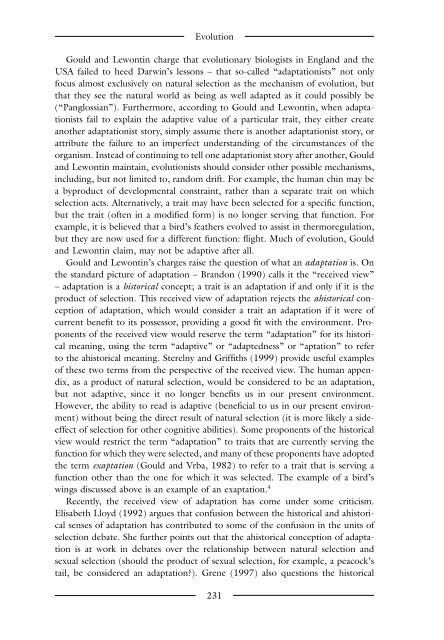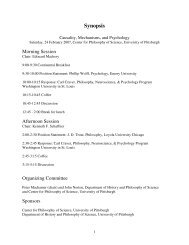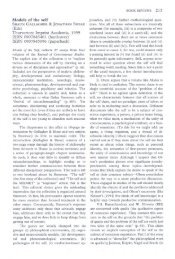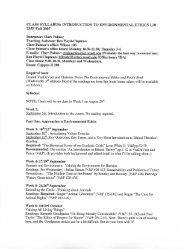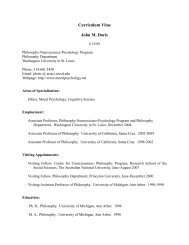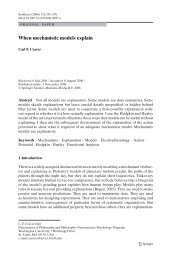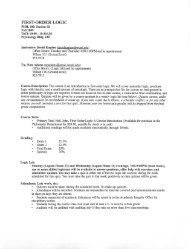The Blackwell Guide to the Philosophy of Science - The Department ...
The Blackwell Guide to the Philosophy of Science - The Department ...
The Blackwell Guide to the Philosophy of Science - The Department ...
You also want an ePaper? Increase the reach of your titles
YUMPU automatically turns print PDFs into web optimized ePapers that Google loves.
Evolution<br />
Gould and Lewontin charge that evolutionary biologists in England and <strong>the</strong><br />
USA failed <strong>to</strong> heed Darwin’s lessons – that so-called “adaptationists” not only<br />
focus almost exclusively on natural selection as <strong>the</strong> mechanism <strong>of</strong> evolution, but<br />
that <strong>the</strong>y see <strong>the</strong> natural world as being as well adapted as it could possibly be<br />
(“Panglossian”). Fur<strong>the</strong>rmore, according <strong>to</strong> Gould and Lewontin, when adaptationists<br />
fail <strong>to</strong> explain <strong>the</strong> adaptive value <strong>of</strong> a particular trait, <strong>the</strong>y ei<strong>the</strong>r create<br />
ano<strong>the</strong>r adaptationist s<strong>to</strong>ry, simply assume <strong>the</strong>re is ano<strong>the</strong>r adaptationist s<strong>to</strong>ry, or<br />
attribute <strong>the</strong> failure <strong>to</strong> an imperfect understanding <strong>of</strong> <strong>the</strong> circumstances <strong>of</strong> <strong>the</strong><br />
organism. Instead <strong>of</strong> continuing <strong>to</strong> tell one adaptationist s<strong>to</strong>ry after ano<strong>the</strong>r, Gould<br />
and Lewontin maintain, evolutionists should consider o<strong>the</strong>r possible mechanisms,<br />
including, but not limited <strong>to</strong>, random drift. For example, <strong>the</strong> human chin may be<br />
a byproduct <strong>of</strong> developmental constraint, ra<strong>the</strong>r than a separate trait on which<br />
selection acts. Alternatively, a trait may have been selected for a specific function,<br />
but <strong>the</strong> trait (<strong>of</strong>ten in a modified form) is no longer serving that function. For<br />
example, it is believed that a bird’s fea<strong>the</strong>rs evolved <strong>to</strong> assist in <strong>the</strong>rmoregulation,<br />
but <strong>the</strong>y are now used for a different function: flight. Much <strong>of</strong> evolution, Gould<br />
and Lewontin claim, may not be adaptive after all.<br />
Gould and Lewontin’s charges raise <strong>the</strong> question <strong>of</strong> what an adaptation is. On<br />
<strong>the</strong> standard picture <strong>of</strong> adaptation – Brandon (1990) calls it <strong>the</strong> “received view”<br />
– adaptation is a his<strong>to</strong>rical concept; a trait is an adaptation if and only if it is <strong>the</strong><br />
product <strong>of</strong> selection. This received view <strong>of</strong> adaptation rejects <strong>the</strong> ahis<strong>to</strong>rical conception<br />
<strong>of</strong> adaptation, which would consider a trait an adaptation if it were <strong>of</strong><br />
current benefit <strong>to</strong> its possessor, providing a good fit with <strong>the</strong> environment. Proponents<br />
<strong>of</strong> <strong>the</strong> received view would reserve <strong>the</strong> term “adaptation” for its his<strong>to</strong>rical<br />
meaning, using <strong>the</strong> term “adaptive” or “adaptedness” or “aptation” <strong>to</strong> refer<br />
<strong>to</strong> <strong>the</strong> ahis<strong>to</strong>rical meaning. Sterelny and Griffiths (1999) provide useful examples<br />
<strong>of</strong> <strong>the</strong>se two terms from <strong>the</strong> perspective <strong>of</strong> <strong>the</strong> received view. <strong>The</strong> human appendix,<br />
as a product <strong>of</strong> natural selection, would be considered <strong>to</strong> be an adaptation,<br />
but not adaptive, since it no longer benefits us in our present environment.<br />
However, <strong>the</strong> ability <strong>to</strong> read is adaptive (beneficial <strong>to</strong> us in our present environment)<br />
without being <strong>the</strong> direct result <strong>of</strong> natural selection (it is more likely a sideeffect<br />
<strong>of</strong> selection for o<strong>the</strong>r cognitive abilities). Some proponents <strong>of</strong> <strong>the</strong> his<strong>to</strong>rical<br />
view would restrict <strong>the</strong> term “adaptation” <strong>to</strong> traits that are currently serving <strong>the</strong><br />
function for which <strong>the</strong>y were selected, and many <strong>of</strong> <strong>the</strong>se proponents have adopted<br />
<strong>the</strong> term exaptation (Gould and Vrba, 1982) <strong>to</strong> refer <strong>to</strong> a trait that is serving a<br />
function o<strong>the</strong>r than <strong>the</strong> one for which it was selected. <strong>The</strong> example <strong>of</strong> a bird’s<br />
wings discussed above is an example <strong>of</strong> an exaptation. 4<br />
Recently, <strong>the</strong> received view <strong>of</strong> adaptation has come under some criticism.<br />
Elisabeth Lloyd (1992) argues that confusion between <strong>the</strong> his<strong>to</strong>rical and ahis<strong>to</strong>rical<br />
senses <strong>of</strong> adaptation has contributed <strong>to</strong> some <strong>of</strong> <strong>the</strong> confusion in <strong>the</strong> units <strong>of</strong><br />
selection debate. She fur<strong>the</strong>r points out that <strong>the</strong> ahis<strong>to</strong>rical conception <strong>of</strong> adaptation<br />
is at work in debates over <strong>the</strong> relationship between natural selection and<br />
sexual selection (should <strong>the</strong> product <strong>of</strong> sexual selection, for example, a peacock’s<br />
tail, be considered an adaptation?). Grene (1997) also questions <strong>the</strong> his<strong>to</strong>rical<br />
231


